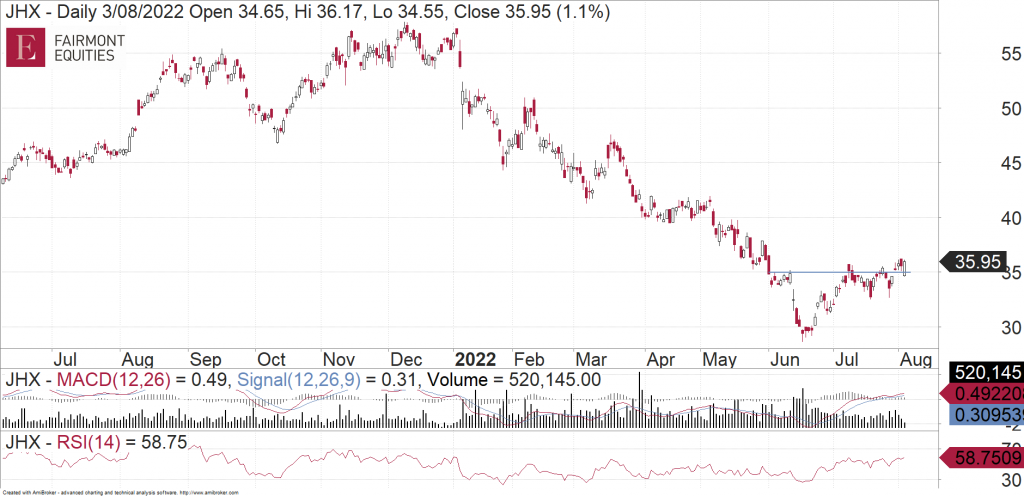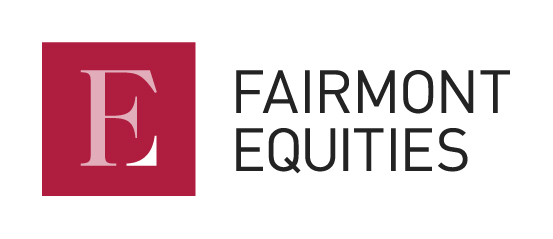James Hardie Industries (ASX:JHX) manufactures and sells fibre cement, fibre gypsum and cement-bonded building products for interior and exterior building construction applications. Their markets are primarily in North America, Australia, Europe, NZ, the Philippines, and Canada. The key value driver for the group are the North America Fibre Cement (NAFC) operations, which account for ~75% of group earnings and 2/3rd of group volume.
Share price weakness since the beginning of May this year has been underpinned by market concerns about the increase in US mortgage rates and concerns over subsequent impacts on the US housing market. The weakness in housing has the potential to significantly impact JHX’s Repair and Remodel (R&R) segment, to the point that earnings weakness from the R&R segment are likely to overshadow the earnings benefit from internal initiatives (such as ColorPlus). In a recent research note in The Dynamic Investor, we noted several factors that have the potential to offset/mitigate the impact from a weaker R&R segment.
Key Fundamental Drivers
R&R Segment Likely to Show Resilience
It is estimated that the R&R segment underpins ~65-70% of JHX’s sales in the NAFC segment. Further, a greater portion of JHX’s North American earnings flow from the R&R market. As such, in the event of a mild recession, the R&R segment should prove resilient, given its growing portfolio of relevant products, a strong channel position and brand and marketing.
Further, R&R activity also tends to be less volatile. In particular, Work-From-Home trends post-COVID are still driving activity, supported by home equity. Home equity is at an all-time high buoyed by recent strong price gains and home equity loan balances remain low by historical standards. The significance here (as it relates to the R&R segment) is that home equity, and related loans, could be an important source of funding for larger improvement projects. Further, while there are numerous pressures on disposable incomes, the fact that 90%+ of mortgages in the US are 30-year fixed, the feed-through of higher rates is somewhat less systemic in their impact.
Proven Ability to Take Share & Grow Ahead of the Market
James Hardie has demonstrated an ability to take share and grow ahead of the underlying US housing market, which is also likely assist in offsetting a declining demand environment. In context, the Company holds a high category share of 90% share of the US fibre cement market. JHX’s share of new housing siding has grown from just 9% in 2005 to 22.2% currently, according to the US Census Bureau annual Characteristics of New Housing data for 2021.
There is an opportunity for JHX to increase its share of the new housing siding market, with the Company previously outlining a 35/90 target (i.e. fibre cement to be 35% of new housing siding in the US; and for JHX to hold 90% share of fibre cement).
Strong Pricing Management
The Company has implemented a strategy to shift demand from lower-value products (e.g. Cemplank) to higher value (e.g. HardiePlank, ColorPlus and new panels) products. It is worth noting that >60% of JHX’s portfolio is currently high-value products.
Annual pricing growth has historically been strong. Further growth in ASPs in North America is expected to occur as JHX transitions from selling Cemplank to HardiePlank (almost 2x ASP). A large proportion (~40%) of price/mix growth is being driven by a continued shift of Cemplank customers to higher-priced product. The transition to ColorPlus (at 3x Cemplank ASPs) also a factor in driving the ASP growth.
As JHX offers premium products, has a strong branding proposition and does not commodity-price, it has historically maintained pricing in the face of declining demand. As such, in the event of a housing correction, the Company could still achieve price increases in the order of 1-2%. Importantly, the shift to premium products is profitable, as the incremental cost of manufacturing a higher-end product is not significant.
Flexible Cost Base
As a high component of JHX’s costs are variable (~80%), in the event of a declining housing market, there is likely to be some relief on costs which could provide margin protection for the NAFC segment. Further, the supply chain continues to pass on cost with success. The buoyancy of current demand and comparatively strong consumer balance sheets seem to still be dealing with cost increases.
In the event that JHX needs to shut capacity, the impact on the Profit & Loss Statement is also relatively contained. Further, JHX has invested incremental manufacturing efficiency gains into R&D and marketing spend, so at least some of this would have a discretionary component that JHX could potentially save on (such as advertising) in the event of a downturn.
Balance Sheet Continues to Strengthen
Gearing (on a net debt to EBITDA basis) has continued to fall in recent periods. Having progressively fallen from 1.9x at the end FY20, gearing as at 31 March 2022 was 0.8x and is well below the target range of 1.0-2.0x.
The steadiness in gearing more recently (also 0.8x as at 30 September 2021) was underpinned by strong operating cashflow. The latter was driven by continued improvement in manufacturing performance, strong profitable organic sales growth and improved working capital (via better integration of the supply chain).
Fundamental View
With expectations for flat-to-declining EPS growth in FY24, the shares are trading at a significant discount to its recent trading history. Having said that, JHX’s overweight to R&R vs new construction will also help brace earnings given R&R downturns are shorter and not as severe as new home construction.
Potential share price catalysts include:
- Company commentary on potential greenfield expansion, as JHX has flagged that they are currently looking for potential greenfield expansion in US and Europe. While recent capacity expansion programs have provided JHX with sufficient capacity to serve the market in the near term, new capacity additions typically indicate the Company’s confidence in longer term growth.
- An update on the search for a new CEO. An interim CEO has been in place since early January 2022 following the departure of Jack Truong, who was a well-regarded CEO. The Company reinforced at the 4Q22 result in May that the CEO search was ‘on track’ with the original 6-9 month timeframe provided in January. As such, an update is likely at either the 1Q23 result (16 August) or Investor Day in September.
Charting View
We looked at the James Hardie chart a few weeks ago and noted that although it was still in a downtrend, it was showing signs of a relief rally with key resistance levels at $35 and then $40. After hitting $35 and easing back, it now looks like it is on the move again with the next target up near $40. Current levels are a buying opportunity.

Michael Gable is managing director of Fairmont Equities.
Current share prices available here.
You can learn more about technical analysis in this article.
An 8-week FREE TRIAL to The Dynamic Investor can be found HERE.
Would you like us to call you when we have a great idea? Check out our services.
Disclaimer: The information in this article is general advice only. Read our full disclaimer HERE.
Like this article? Share it now on Facebook and Twitter!

